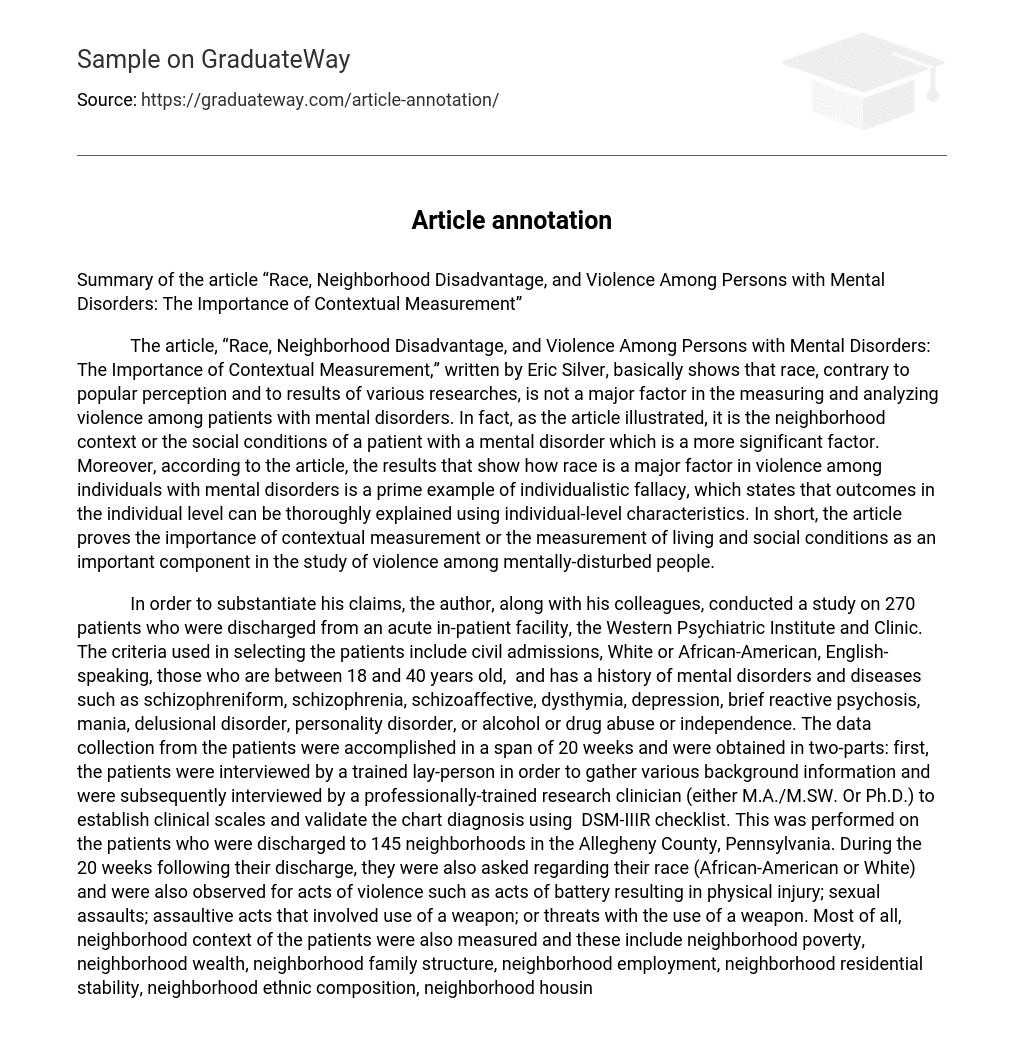Summary of the article “Race, Neighborhood Disadvantage, and Violence Among Persons with Mental Disorders: The Importance of Contextual Measurement”
The article, “Race, Neighborhood Disadvantage, and Violence Among Persons with Mental Disorders: The Importance of Contextual Measurement,” written by Eric Silver, basically shows that race, contrary to popular perception and to results of various researches, is not a major factor in the measuring and analyzing violence among patients with mental disorders. In fact, as the article illustrated, it is the neighborhood context or the social conditions of a patient with a mental disorder which is a more significant factor. Moreover, according to the article, the results that show how race is a major factor in violence among individuals with mental disorders is a prime example of individualistic fallacy, which states that outcomes in the individual level can be thoroughly explained using individual-level characteristics. In short, the article proves the importance of contextual measurement or the measurement of living and social conditions as an important component in the study of violence among mentally-disturbed people.
In order to substantiate his claims, the author, along with his colleagues, conducted a study on 270 patients who were discharged from an acute in-patient facility, the Western Psychiatric Institute and Clinic. The criteria used in selecting the patients include civil admissions, White or African-American, English-speaking, those who are between 18 and 40 years old, and has a history of mental disorders and diseases such as schizophreniform, schizophrenia, schizoaffective, dysthymia, depression, brief reactive psychosis, mania, delusional disorder, personality disorder, or alcohol or drug abuse or independence. The data collection from the patients were accomplished in a span of 20 weeks and were obtained in two-parts: first, the patients were interviewed by a trained lay-person in order to gather various background information and were subsequently interviewed by a professionally-trained research clinician (either M.A./M.SW. Or Ph.D.) to establish clinical scales and validate the chart diagnosis using DSM-IIIR checklist. This was performed on the patients who were discharged to 145 neighborhoods in the Allegheny County, Pennsylvania. During the 20 weeks following their discharge, they were also asked regarding their race (African-American or White) and were also observed for acts of violence such as acts of battery resulting in physical injury; sexual assaults; assaultive acts that involved use of a weapon; or threats with the use of a weapon. Most of all, neighborhood context of the patients were also measured and these include neighborhood poverty, neighborhood wealth, neighborhood family structure, neighborhood employment, neighborhood residential stability, neighborhood ethnic composition, neighborhood housing stock.
Initially, the results showed that the odds of violence for the African American patients were 2.7 times greater than the odds for Whites. However, another comparative result showed that when neighborhood disadvantage or poor social and living conditions were added to the equation, the effect of patient racial status was virtually eliminated and the odds ratio between the African-Americans and Whites were reduced by more or less 50%. Meaning to say, despite the prevailing association between race and violence, African-Americans and White patients who reside in a disadvantaged and impoverished neighborhood showed no differences in their potential to commit violence.
The article concludes that when neighborhood context is taken into consideration, the race of a person with a mental disorder does not affect his or her capability for violence, contrary to the results yielded by other researches and studies. Most of all, this proves the negative effects of individualistic fallacy and highlighted the importance of contextual measurement or the assessment of living and social factors other than race.
References
Silver, E. (2000). Race, Neighborhood Disadvantage, and Violence Among Persons with Mental Disorders: The Importance of Contextual Measurement. Law and Human Behavior, 24, No. 4, 449-456.





